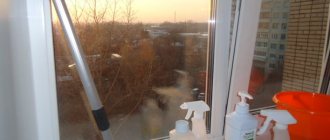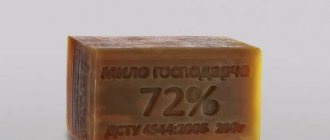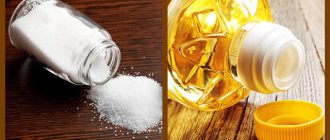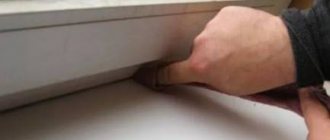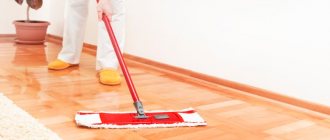To wash the plastic profile from the polyurethane seal, use White Spirit, a remover for mounting guns, or vegetable oil. A pharmaceutical product called Dimexide may also come in handy. To clean glass after repair, you can use vinegar, acetone, or scrape off the remaining sealant with a blade.
It happens that during the installation of windows, builders carelessly stained the profile of a plastic window, glass or window sill with polyurethane sealant. An unfortunate accident. It is unlikely that you will be able to wash construction foam with powders, soap or Fairy; you will spend a lot of time and effort, and the effect will be barely noticeable. Let's look at the tools that work.
Doors and windows
The polyurethane composition includes catalysts and stabilizers, which are responsible for the consumption and foaming of the material. After the expiration of the specified excess balances are very difficult. There are effective ways to clean polyurethane foam without damaging the area being treated.
Basic means for cleaning polyurethane foam from the surface of a door or window opening:
- Acetone and a liquid based on it effectively dissolve the polyurethane mixture, but will leave marks on the varnished surface.
- To remove fresh composition, cleaning agents ULTIMA and PENOSIL are suitable, which effectively remove the applied sealant.
- Professional products Penosil-Premium, Cosmofen, Isofoam R621 are used to remove hardened residues from plastic.
Pharmacies sell the drug Dimexide, which has good dissolving properties. Dimexide removes hardened composition from any surfaces, gradually destroying the foam structure.
Important: When using Dimexide, you must wear gloves, as there is a risk of burns. Complete cleaning of the hardened polyurethane foam occurs within 24 hours.
PVC material
Polyurethane sealant is most often used to insulate plastic windows, so excess insulation remains on the surface of the glass unit, frame, and window sill. When applied very carefully on the surface of a plastic window in the area of the gaps, the mass hardens into unsightly drops, which can be cleaned in the following way:
- The visible part of the composition is carefully trimmed with a knife and removed.
- Apply a little vegetable oil to the resulting stain.
3. To clean foam from plastic windows, allow the oil to soak in for 15 minutes.
After softening, the marks can be easily washed off with a dish sponge. It is not recommended to use chemical reagents to avoid damaging the plastic. The oil will be washed off from the PVC with any detergent.
Another option is to use pharmacy Dimexide. To clean polyurethane foam from plastic windows, balconies, doors, an inexpensive gel is applied to the stain (always wearing gloves) and evenly distributed with a brush. After a few minutes, you need to wipe the cleaned area with a damp cloth.
Attention: Plastic does not interact well with solvents and strong reagents. There will be stains on the surface of the window or door panel.
Wooden structures
Polyurethane sealant is used to seal gaps in wooden windows and doors. To protect wood from moisture and the formation of fungus and mold, it is coated with paint and varnish. Using the folk method, you can wipe off the foam from a wooden door or window frame. To do this, you need to dissolve a spoonful of salt in a glass of plain water. You need to treat the contaminated area with the prepared mixture, and then wipe off the foam from the door with a sponge.
To make the foam wipe off easily, you can leave the saline solution for a few minutes. After this, rinse off the product - no stains remain on the varnished or painted wood. Salt will remove foam from the door leaf in a few minutes, and using a scraper may leave small scratches.
Folk remedies for cleaning windows
The question of how to clean polyurethane foam from clothes is relevant for almost all people, because clothes most often end up contaminated.
It is virtually impossible to completely remove foam from fabric, since it binds extremely tightly to the fibers.
But you can completely reduce its effect on the fabric. It’s worth mentioning right away that it is better not to use substances containing acetone, since acetone can change the color of clothes and even ruin them.
How to wipe off polyurethane foam that gets on clothes? The following options are suitable for this:
- White Spirit;
- stain remover;
- gasoline solvent.
This is pure gasoline, containing no impurities. It is this type of gasoline that must be used; - foam solvent.
Now let’s look at how to wash foam from clothes, not how to:
- The foam cap (fresh or already hardened) is removed from the surface of the fabric.
- One of the above compounds is applied to the stained area.
- There is a pause of 15 minutes.
- Remains of the substance are removed with a cloth, sponge or soft brush.
- If traces of foam remain on the fabric, the function can be repeated.
- Clothes are washed using powder and stain remover.
Tile
Tile is a surface that can be washed in any way. Starting from folk methods (bite, oil) and ending with professional means (White spirit, thinner, gasoline, etc.).
Glass
Fresh sealant can be easily removed using a cotton swab dipped in vinegar or white spirit. However, as mentioned earlier, it is much easier to wait until the foam dries. Cut off the protruding part with a knife, and scrape off the remaining parts with a blade. All other previously described means will serve as an alternative.
We suggest you familiarize yourself with an insulated bottle floor in a bathhouse with your own hands, how to prepare and install it. Bottle sauna
Windowsill
PVC window sills are cleaned according to a principle similar to glass structures. Of course, the composition of plastic is different from glass, so before any “experiment”, test the effect of the solution on the bottom of the window sill or on the side. Window sills and slopes lined with ceramic tiles can be washed without any problems with any commercially available detergents.
Wooden window sills must not be washed with gun cleaner, acetone, solvents, or a product called “White Spirit.” In such cases, vegetable oil is an excellent alternative.
Floor coverings
- Linoleum - if there is no textured pattern, then let the foam dry. After a while you can tear it off without any problems. If there are pores or dented patterns on the linoleum, use White Spirit or acetone. Apply the product, and then very carefully remove the layer with a chisel. Plain water will be an excellent help. Cut off the protruding part of the sealant and place a wet rag on the remaining part. After 8 - 12 hours, the foam will soften and can be removed without much effort.
- Laminate - hot vegetable oil or liquid for washing construction guns. Please note that excessive use of water may damage the laminate flooring, causing it to swell.
- Carpet - "Dimexide", gasoline or kerosene.
The main difficulty when cleaning wood or parquet is the varnish, which deteriorates when in contact with most products. There are few options left, and they will not always show 100% effectiveness. Try to get rid of the top layer of foam mechanically, and remove the remaining residue with vegetable oil.
Got your furniture upholstery dirty? First of all, try not to smear the foam. Wait until the sealant has completely dried, and then remove it from the surface of the fabric. If foam gets on a long pile, you will have to cut off the lump along with a small part of the fabric.
If the sealant gets on a smooth fabric, then gasoline, Dimexide or kerosene will help you. If polyurethane foam gets on the removable cover, you will need to soak it for 12 hours. Similar operations are carried out with clothing.
Linoleum
An important advantage of linoleum is its water resistance, so the floor covering does not absorb liquids. The easiest way to remove polyurethane foam from linoleum is to let the composition harden. Polyurethane cannot penetrate deeply into the structure of the floor covering. After hardening, you can clean the mounting foam from linoleum as follows:
- Carefully cut off the top mass with a knife.
- Take nail polish remover without acetone.
- Wipe stains with a soft sponge and rinse.
Another option for removing hardened polyurethane foam from linoleum is treatment with Dimexide. The composition has a gentle effect on the floor covering. Foam cannot be removed with acetone, since matte stains will remain on the linoleum forever.
How to clean polyurethane foam
During repairs, polyurethane foam can contaminate walls, glass, and most often the floor. Each surface has its own cleaning products. The fact is also taken into account what condition the sealant is in: dried or fresh. Fresh areas are easier to remove, but not on all surfaces.
There are ready-made polyurethane foam cleaners available for sale. They must be used after reading the instructions.
If cleaning agents are used, it is recommended to pre-treat the area in an inconspicuous place. If no changes have occurred to the surface, then use it to clean the entire contaminated surface.
From plastic windows and panels
Often craftsmen leave traces of polyurethane foam after installing plastic windows and panels. The mark is noticeable and the appearance is spoiled, so removal is required. You can remove polyurethane foam from such a coating in the following ways:
- If the sealant is frozen, then cut off as much as possible with a sharp knife. The cut is made carefully so as not to damage the surface itself.
- Moisten the remaining parts with pharmaceutical dimexide or a special means for removing from hard surfaces.
- The composition is left for a couple of minutes. During this time, the particles are destroyed, and the marks are removed with the hard side of the washcloth.
- For fresh stains, use oil and vinegar. They are applied with gentle movements and left for 5-10 minutes. Then it is removed with a sponge.
- In both cases, after removing the contamination, the surface is washed with soapy water and wiped dry with a clean, soft cloth.
Cleaning is also done with acetone. But you need to work with it with special care, as stains may form on the PVC. It is better to test in an inconspicuous area.
When working with dimexide, you should wear gloves on your hands.
From linoleum and laminate
There are different ways to clean prefabricated material from linoleum. They depend on the condition of the composition.
If the sealant has not hardened and has not had time to adhere to the coating, then the mass is removed with a rubber or wooden spatula. The removal process starts from the edge to the middle. Residues are wiped with solvent.
When using acetone, you should take into account the fact that it leaves marks on the linoleum in the form of matte spots.
To prevent the cleaned area from standing out, it is wiped with a rag soaked in linseed oil.
If the composition has hardened, cut it with a sharp knife as close to the plane as possible. Do not cause scratching of linoleum. Residues are removed with special solvents or folk remedies (oil, vinegar). Next, rub with linseed oil.
Among the ready-made options for removing contaminants are the following:
- BeLife Foamcleaner is a spray for cleaning sealant that has not set. They clean the mounting gun from any remaining mass after use. The product is spread onto the surface, left for 20 minutes, then wiped with a rag. The work must be carried out using IZ.
- Tytan Professional Eco Cleaner is a professional product. With its help, you can easily wipe off the mounting foam from linoleum. Suitable for uncured composition. The product is applied to the area, left for 15–25 minutes, then the contamination is removed with a clean rag. The liquid leaves no traces. Does not contain harmful additives, therefore it is an environmentally friendly product.
Carpets
Soft textiles and fleecy fabrics easily bond with polyurethane sealant, which penetrates into the fibers, and it will be difficult to remove dried foam with a knife or scraper. In addition, there is a risk of damaging the material.
Depending on the type of carpet, you can clean the foam in the following ways:
- Carpet - the remains are carefully cut off with knives closer to the surface of the floor covering and thoroughly washed with water.
- Carpet with pile - cover with a wet rag to soften it, then scrape it off with a spatula.
- Lint-free carpet - use varnish solvent, acetone or Dimexide. After treatment, the carpet is washed with detergent.
If the dirt has become deeply embedded in the fleecy fabric, part of the pile will have to be cut off or plucked out. Foam is easier to clean from carpet, but fabric coverings after treatment with chemical compounds must be washed or dry-cleaned so that a specific odor does not remain.
How to wash polyurethane foam - instructions for removing foam from any surfaces
Most exterior and interior home construction or renovation work requires the use of polyurethane foam.
Without it, it is difficult to imagine the installation of windows and doors, insulation and siding, and pipe installation work. The foam firmly fixes individual elements and also firmly adheres to surfaces on which it should not be. Ideally, all foaming work should be carried out so that it does not protrude from voids and, especially, does not fall into open areas. But troubles happen even to professional craftsmen, not to mention home craftsmen, who often take on repairs for the first time. So how and with what to wash the polyurethane foam?
- Fresh foam
- Cured foam
- Delicate surfaces
- Leather and fabric
Fresh foam
Fresh foam is the easiest to remove. It must be collected immediately (but not with bare hands!), using a plastic or other non-scratching scraper, and cleaned off as much as possible without smearing. Then use a hard cloth or sponge and solvent, depending on the type of coating. The following substances have proven themselves to be the most effective.
- The most affordable option is acetone or solvent 646. However, these products are not suitable for vinyl siding or plastic lining, the surface of which will simply peel off from such aggressive substances.
- Isofoam r621 is a special Russian-made product for washing foam guns, but it also copes with foam on other surfaces. A 600 ml bottle costs less than 100 rubles.
- Cosmofen is a favorite product of window installers. There are three types of Cosmofen 5, 10 and 20. “5” is the strongest, “20” is the weakest. Suitable for removing foam from plastic and glass. The downside is that it’s sold in one-liter bottles, so it’s not the cheapest option for cleaning a small area.
- Macroflex remover softens the foam well and makes further scrubbing easy.
Laminate
The best method to remove polyurethane foam from laminate is to use branded removers. Powerful components effectively clean the laminated coating from various types of contaminants. When the sealant composition is destroyed, it is removed with a piece of cloth or a sponge. You can use Dimexide, especially to remove fresh dirt.
How to remove polyurethane foam from a laminate using a chemical composition:
- Wear gloves, open windows and doors so that the room is well ventilated.
- Scrape off the top layer of sealant from the laminate with a spatula, knife, or scraper.
- Treat the surface with a chemical compound, preferably before it dries.
- Wipe the laminate with a sponge, rinse off any remaining substance with detergent.
You can use acetone, Dimexide, solvent 646, special composition “Macroflex”, “Cosmofen” to clean the tube or gun from polyurethane foam. The components of the removers do not destroy the structure of the laminate, but they should not be used for cleaning plastic or siding.
Parquet and parquet boards
Floor coverings made of parquet and parquet boards are painted and varnished to protect against moisture and highlight the structure of the wood. Aggressive chemical components corrode the varnish if used on a parquet floor. To better remove stains, complete polymerization must be prevented. As soon as the polyurethane dries slightly and stops sticking to your hands, you need to carefully pull the edge of the foam mass and tear it away from the parquet. Traces can be removed with any cleaning agent.
If the mass has hardened greatly, cut off the remaining sealant with a knife. The area of contamination is treated with Dimexide solution. After 15 minutes, the mounting foam will be easily wiped off, and no traces of dirt will remain on the varnished surface. Before applying chemical compounds, you should check their effect on the parquet in an inconspicuous place. If the varnish is destroyed, it is better to choose Dimexide.
Sealant on clothes
Even when using a gun, the polyurethane compound can get on the fabric, so recommendations on how to remove polyurethane foam from clothing will not hurt:
- Solvents and cleaners destroy the fabric structure.
- Dried polyurethane foam cannot be washed off clothes.
- White spirit, gasoline or stain remover are suitable.
- After a few minutes, wipe off the polyurethane. Depending on the type of fabric, the stain is removed completely or partially.
The best way to clean frozen foam from clothing is to wipe the item with clean gasoline. It does not contain impurities and cannot spoil the fabric or change its color. After treatment, you can wash the polyurethane foam by hand or in a machine.
On video: How to remove polyurethane foam from clothes
How and with what to remove polyurethane foam from plastic windows?
Polyurethane foam is a means for performing construction and repair work, external and internal.
As an adhesive, sealant, heat and sound insulation. It is necessary when installing doors, windows, plastic pipes, siding, and plastic panels. Professional work with polyurethane foam
- How to prepare for work with polyurethane foam?
- What solutions clean traces of polyurethane foam well?
- Special products for washing tools, windows or hands
- Aerosols and pastes that soften dried foam
- Common solvents and improvised means
- How can a housewife quickly and efficiently wash foam from PVC windows?
In operation, polyurethane foam can exhibit an annoying property: it sticks in undesirable places and leaves blots that quickly stick and contaminate the surfaces of nearby objects. Moreover, they cannot be washed off with water; it is dangerous to wipe them off with solvents and dry rags. This problem is relevant for inexpensively purchased PVC windows, on which inept cleaning of foam stains can forever leave irreparable marks or damaged areas that disrupt the aesthetics of the window and spoil the appearance of the entire room.
We use the freezer
Since the polyurethane composition has good contact with fabrics, washing off foam from clothing with water and soap solution will be ineffective. If there are foam splashes left on things, you should use the freezing method. To do this, clothes with traces of sealant are placed in a plastic bag and left in the freezer for 60 minutes. Take out the bag and remove the frozen remains of the sealant from the fabric.
How to remove polyurethane foam from clothes, if there are stains left, remove them with a stain remover. After treatment, clothes need to be washed; you can use a product for delicate fabrics. The stain remover effectively removes marks from clothing, but it is better to check the reaction of the fabric to the composition used in an inconspicuous place.
From hair
The remaining foam in the hair is the most unpleasant moment when using polyurethane mixtures. Foam on the head is difficult to wash off, and if it has dried out, only special products can help remove it. How to remove foam from hair:
- Liquid flakes are carefully wiped with a dry cloth so as not to smear.
- The remaining traces are treated with a special cleaner, moistening a napkin in it; you can use acetone if there is no allergy.
- Vegetable oil helps to effectively remove foam.
After treatment, you need to wash your hair thoroughly and use skin cream. It will not be possible to wash off the dried mass without mechanically cleansing the hair. Use a pumice stone, a brush, or a comb to comb your hair well, trying not to touch the scalp. The sealant hardens quickly enough; to soften and remove it from the hair, you need to use vegetable oil, Dimexide, acetone, and hair remover.
Important! When using Dimexide to clean hair from foam, Dimexide should be diluted with water in a ratio of 1:3.
From hand
To avoid having to get rid of polyurethane foam on your hands, you need to work with polyurethane sealant while wearing gloves. There are several recommendations on how to wash off foam from your hands:
- Washings and aerosol solvents, in the absence of allergies.
- Try removing it with white spirit, acetone, or pure gasoline.
4.Prepare a saline solution and wash off the foam from the skin
5. The oil softens marks on hands from polyurethane foam.
6.Rub the skin with salt and remove the foam from your hands by washing.
It is very important to lubricate your hands with a rich cream after treatment so that the skin does not dry out. People who are allergic to aggressive solvents should use only natural products.
What is the best way to wash dried foam from the body?
If you do nothing, the polyurethane foam itself will fall off from your hands, feet and other parts of the body within a few days. You can wait if it's not critical.
When the sealant causes inconvenience, it is removed in the following ways:
- Using a regular rock salt solution. To do this, make a solution of salt and water in a container in the proportion of 100 g of salt per 300 g of water. Next, you need to dip your hands and hold for a couple of minutes. If your feet get dirty, you can apply a cloth soaked in the solution to the area of the body. After 5 minutes, you can clean the dirty area with a pumice stone or a sponge with an abrasive surface.
- When you have alcohol, 3 percent vinegar, acetone, construction solvent or gasoline on hand, you can treat the skin with these products. The top, convex layer of the mounting agent must be cut off with a knife, and the remaining foam can be easily cleaned with solvents. The sealant is non-toxic, so no need to worry if it remains on your body. This is not dangerous.
- Warm sunflower oil. You need to smear it on contaminated skin. Then sprinkle the area with washing powder and rub thoroughly until foam forms. Afterwards, the substance is washed off and the treated area is lubricated with cream.
- Simple soap. The skin is washed well, wiped with a washcloth, and then thoroughly rinsed with running water.
Regular gloves will help protect your hands from the mounting sealant. Don’t forget about them if you need to foam something at home. Then there will be less problems with cleaning the remaining foam.
Various types of surfaces
Professionals know how to carefully work with assembly sealants and use guns to evenly fill gaps, seams and voids in structures. Excess polyurethane is dissolved with a special remover. The composition should be selected depending on the type of surface, since materials react differently to chemicals.
Stone
To remove traces of polyurethane from tiles, stone countertops, and window sills, use foam solvent. On the packaging, the manufacturer indicates that the product is intended specifically for removing polyurethane foam from stone surfaces. Simply apply the composition and wipe with a sponge. Sealant from stone can be wiped off with Dimexide, acetone and white spirit. After using the cleaner, wipe the stone with a dry cloth.
Tree
To remove the remnants of the polyurethane composition, use a cleaning agent for polyurethane foam or Dimexide. Chemicals penetrate deep into the pores of the wood, effectively dissolving sealant particles. You can leave it for an hour so that the wood is well soaked. Remove dirt with a soft brush or rag.
Concrete
When sealing joints in concrete walls and ceilings, part of the installation composition may leak into the adjacent area. The structure of concrete is porous, so the foam can be dissolved with an aerosol cleaner. The spray can is directed onto the concrete, sprayed and waited for several minutes. The sealant begins to decrease in volume, the residue can be easily scraped off with a spatula. Before removing foam with a proprietary solvent, you need to wear gloves and organize ventilation in the room.
Metal
To give the metal anti-corrosion properties, the material is painted. Using chemical solvents to clean metal doors can corrode the paint or powder coating. The use of a dried foam cleaner is possible on unpainted metal structures. If there is a risk of damaging the appearance of an iron door, it is better to use Dimexide. It must be rubbed in for 25-30 seconds, and then wipe off the thin film. You can moisten the stain with sunflower oil and then wipe it off with a sponge.
Glass
Solvents are used to remove polyurethane foam from glass surfaces. First, the sealant is allowed to harden, then the top mass is removed with a sharp blade or knife. Stains are treated with gun cleaner, household and automotive chemicals. Contaminants can be easily removed from the glass surface with nail polish remover. When cleaning foam from glass, you need to work carefully so as not to scratch the window or doors.
Delicate surfaces
If during the insulation process polyurethane gets on furniture upholstery, leather or textiles, it will be difficult to clean the dried polyurethane foam. Not all materials can be used with Cured Foam Cleaner. It is necessary to remove the contamination mechanically and wipe the stain with a safe solvent, for example, white spirit. In any case, first check the reaction of fabric or leather upholstery on an inconspicuous area of furniture.
Polyurethane dissolves well in chemicals, acetone and Dimexide. When choosing a cleaner, you need to take into account the structure of the surface being treated, carefully read the manufacturer’s instructions for what purposes the solvent is suitable. Before performing work, you need to cover the furniture with old sheets, roll up the carpet, put on a hat and gloves.
Effective means for removing polyurethane foam from various surfaces
Washing fresh foam
Important! Do not try to remove stains with acetone, solvent No. 646 or No. 647; of course, they dissolve the foam, and at the same time the top layer of coating. You should also not use products containing concentrated acids and alkalis; they will not harm the profile, but they can dissolve the glossy layer, and the plastic will look worse. Hard brushes and cleaning powders scratch plastic, so it’s best not to use them either.
It so happened that during work the sealant accidentally got on some surface - you can wash it off immediately or wait until it dries. Most often, it’s enough to simply pick at a dry foam build-up with a spatula and it will fall off, but if you managed to smear the foam all over the window sill, it will penetrate into the material and it will be very difficult to wipe it off.
If you decide to wash the fresh sealant, then take two spatulas in your hands and carefully move the lump of sealant onto the other with one spatula. To remove the remaining mark, use one of the methods suggested below.
Hot vegetable oil
Heat sunflower or other vegetable oil, wet a rag and vigorously scrub the contaminated area. This product is good because it does not have such a strong smell as chemicals. drugs are cheap and will not harm the health of household members. Thus, you can wash a stained window, door, polished furniture, vinyl wallpaper and any other material. You can also try to eliminate dried marks with oil, but then after application you need to cover it with a rag and leave for 30 minutes, after which you can rub it.
Vinegar
Another “home” remedy that is always at hand. Soak a napkin in undiluted vinegar and, using force, wipe off any remaining sealant. This method works very well for removing sealant from glass, tiles and other smooth surfaces.
Chem. drugs
Until the polymerization process is completed, the sealant can be wiped off with a cloth soaked in White Spirit or an ethyl acetate-based mounting gun cleaner. If neither one nor the other is at hand, then it is better not to touch or smear it at all, let the foam dry, then it can be easily cleaned off with a blade.
When using chemicals, wear rubber gloves and work in a well-ventilated area.
